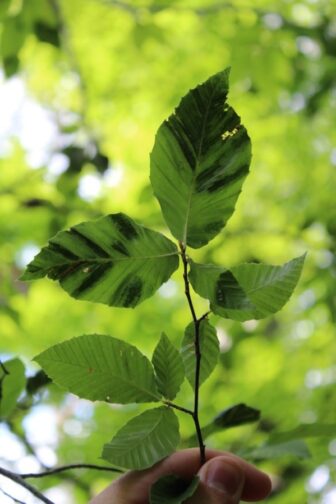
One symptom of beech leaf disease is dark striping on leaves. Image: Tom Macy
By Shelby Frink
Researchers in Ohio are getting ready to expand one of seven treatments for a widespread disease that kills beech trees.
Cleveland Metroparks, which contains 18 nature reserves, hosts these treatment trials.
The invasive beech leaf disease causes dark striping on leaves and makes them thick, leathery and disfigured before killing the tree, said Tom Macy, the forest health program administrator for the Ohio Department of Natural Resources.
Beech leaf disease was first seen in 2012 in northeast Ohio, said Danielle Martin, a forest pathologist for the United States Department of Agriculture.
Microscopic worms called nematodes were discovered in 2017 on diseased leaves, Macy said. Researchers confirmed in 2020 that the nematodes are directly linked to the disease.
A chemical called PolyPhosphite 30 was used experimentally on saplings in 2017 to strengthen the plants’ defense against the disease, said Daniel Volk, the forest health project coordinator for Cleveland Metroparks.
There are no harmful side effects of PolyPhosphite 30 to the environment, Volk said. In 2021 the treatment expanded to include larger trees.
“We just sampled for nematodes this past fall and there’s a significantly larger number of nematodes in untreated trees compared to treated,” Volk said. Symptoms in leaves have also decreased.
Cleveland Metroparks is also testing two insecticides on beech trees, Volk said. Insecticides can harm native insects, so they are injecting them directly into the stems to prevent unintended environmental exposure.
It took five years of applying PolyPhosphite 30 before researchers could see clear results that it worked, Volk said. Researchers are hoping the other two insecticides show faster results.
Scientists are preparing to use PolyPhosphite 30 in areas beyond Cleveland Metroparks, Volk said. They want to collect more data on the other two insecticides before expanding those treatments.

Researchers are continuing to find evidence of beech leaf disease since it was first observed in 2012 in the Great Lakes region. Image: Cleveland Metroparks
“The big concerning factor is the rate of spread across the country,” Volk said.
Since 2012, beech leaf disease has been found in Pennsylvania, New York, Connecticut, New Jersey, Virginia, West Virginia, Massachusetts, Rhode Island, Maine and Ontario, Martin said. Saplings die around three years after symptoms appear.
Mature trees that become infected may stick around for 7 years, Volk said.
Most recently, researchers have looked at trees that are genetically resistant towards beech leaf disease as a possibility for breeding purposes, Volk said. They are taking branch segments from resistant trees and testing them against the nematodes.
Researchers are waiting on results.
“It’s going to be a long process, but we’re starting that now,” Volk said.
The chemical treatments will be applied again in July.
Philip – could you share the name of the arborist? I am in Amagansett and our beeches are also showing evidence of the disease. Thank you so much.
Two of the 5 Copper Beech on Wickapogue Road in Water Mill have been infected; two Copper Weeping Beech and two Green Weeping Beech in the interior of the property do not show signs of infection.
Frustrating that many of the Arborists in the Hamptons are not up to date to this disease and current treatment!
I believe I finally have found a dedicated arborist, will keep all informed of our progress.
Round House gardens in East Hampton, Long Island has 22 infected European beeches, all beeches of this genus in the garden. So far two copper leaf beeches, two weeping beeches and a fern leaf beech have not (yet) shown signs of infection.
My Beech trees in Garrettsville Ohio are infected
would appreciate being informed of treatment for Beech Tree leaf disease.